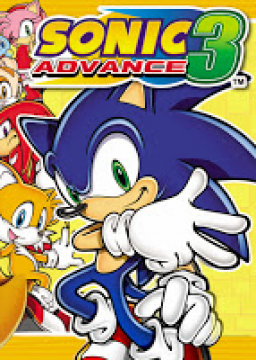Spin Dash:
When you are standing still, press and hold the D-pad down, then tap A once or twice. Release the D-pad to blast off in a burst of speed. Two tap spindashes are faster than one tap, though there are instances where one tap dashes can be useful. A+T and A+C cannot spindash, whereas A+K can spindash without rolling. Generally speaking, the best way to accelerate without a tag action is to do a 2-tap spindash and a very short hop, then a full jump. Read Ball Mode for more info.
Ball Mode:
You enter ball mode if you press down while moving or do a spindash (exceptions are A+T, A+C, and A+K). In ball mode, you accelerate more when going downhill, but otherwise always decelerate. Generally, you want to avoid staying in ball mode unless you're going downhill; jumping is a common form of getting out of ball mode, especially with a downhill slope jump.
Furthermore, if you jump out of ball mode, you have no air control until you land, and you won't accelerate. This is why out of a spindash, you want to jump out of ball mode with a short jump and land as soon as possible, so you can start running on foot instead of in ball mode. After you land, you can do a full jump while retaining air control to accelerate even more quickly in the air. See Aerial Speed for more details. Certain actions in the air regain air control if you jump out of ball mode, which allows you to start accelerating or pulling back. Such moves include insta-shield, firing cheese, air-spinning if partnered with Amy, or flying.
Slope Jump:
When floors are not level, the incline affects the angle and speed of your jumps.
When jumping off an uphill incline, the character will go much higher but not as horizontally far and lose horizontal speed. The steeper the hill, the more extreme the effect (i.e. more height). You want to do uphill slope jumps if you need height.
When jumping off a downhill incline, the character will not gain much height, but will gain much distance (and sometimes horizontal speed). The steeper the hill, the more extreme the effect. You want to do downhill slope jumps if you want to accelerate more quickly or break out of ball mode.
Loop Jump:
A variation on the Slope Jump, which takes place inside a loop. If you enter a loop from the left and jump from its top left, you catch the next corner of the loop and are propelled off, gathering more momentum than usual. You get the same effect if you jump from the top right of a loop after entering it from the right.
Aerial Speed:
Sonic Advance 3 is different from other 2D sonic games in that when in the air, your character will accelerate much more quickly than on the ground, even when ascending. This means that you want to jump to accelerate, since your aerial acceleration is higher than ground acceleration. Jumping out of spindashes is the fastest way to accelerate without tag actions.
Rails:
Your character will always land on a rail first try (exception is at specific angle changes, this is a case-by-case basis). However, the moment you jump off that same rail, you can't land on it again. If you want to get off of a rail, just jump again. If you want to land on it, try to aim for spots that aren't angle changes. If you want to go through a flat part of a rail, the fastest way to do so is to time a tag action such that it finishes charging the moment you land on the rail, which kicks you off the rail.
Tricks:
Similarly in Advance 2, Rush, and Rush Adventure, you can trick off of ramps, hoops, and springs. By pressing R after hitting one of these, you can trick forward (back is the same as forward in this game), up, or down. There are some things to note about tricks in this game:
- Only S+T, T+S, A+C, and C+A can trick. Their tricks are mostly the same as the lead character's tricks in Sonic Advance 2.
- Your character will initiate a trick upon RELEASING the R button, not when you press it. So after you hit a spring/hoop/ramp, you have to press R then release it at the moment you want to trick.
- You cannot charge a tag action during a trick.
Boost Mode
Boost Mode is a returning mechanic from Advance 2 and works similarly for the most part. Only teams with Sonic (either as lead or partner) can enter boost mode. In boost mode, the lead character moves and accelerates much more quickly, exceeding a grounded speed cap that would take place without boost mode.
You can enter boost mode through the following methods:
- Running for a long period of time (speed shoes make this happen much more quickly)
- Hitting boost pads
- Using Sonic's Tag Action
You lose boost mode if any of the following happen:
- Get hit
- Finish charging a tag action
- Don't have enough grounded speed when on ground
- Use any attack or aerial action
Note that you can still maintain boost speed in the air even if you lose the actual boost mode. For example, if you jump out of boost mode then finish charging a tag action, you are still moving at boost speed (but you'll lose it when you land). Another key example is if you fly as Tails/Cream (especially Tails), you can maintain a lot of your boost speed.
Tag Action
The Tag Action is the unique feature in this game that differentiates it from all other sonic games, and adds another layer of depth in execution. This mechanic has so much depth that it deserves an entire section to itself in this page.
In a given team, the second character has the ability to perform a supporting action for the lead character, called the tag action. To perform a tag action, start holding the R button (default controls). After 1.5 seconds, the support character will automatically jump into the lead characters hands, and you can release R to perform the tag action at any time after this happens.
While charging a tag action, if the charging animation is interrupted, but R is still held, then the tag action will begin charging as soon as possible, except it will only take 1 second to charge. This is a VERY important mechanic to understand and take advantage of. Interrupting the charging animations includes (but is not limited to) the following:
- Taking damage
- Running up a wall or through a loop
- Running through a spiral
- Attacking
- Flying
- Grabbing a pulley
For example, suppose you need to have a tag action charged as soon as possible after coming out of a loop, but 1.5 seconds is too much time. If you start charging after coming out of the loop, you'll end up waiting a bit to finish charging before using it. However, if you charge before entering the loop, keep holding R, have it canceled by running through the loop, then it will only take 1 second to charge upon exiting the loop, saving 0.5 seconds over otherwise.
What the tag action is depends on two things: who the support character is, and whether it is used on the ground or in the air. The lead character does not change what the Tag Action is. Here is a list and analysis of all the tag actions for each support character.
Sonic
Ground Tag Action: Give the lead character a sudden burst of speed forward and puts him/her in boost mode. Air Tag Action: Same as ground, but in the air.
Both of Sonic's tag actions literally put the lead character on an invisible grounded boost pad for one frame. This means that by pressing A the frame R is released, the lead character can jump in the air. This can be pause buffered by charging the tag action, pausing, letting go of R and holding A, then unpausing while continuing to hold A.
It's also important to note that by rolling or jumping the frame this tag action is used, the lead character hits the boost pad for two frames, moving 20% faster than otherwise. As a result, for maximum speed, it's generally best to always either hold down while releasing R, or buffer a jump from the tag action. There are a few cases where doing a normal slower tag action is more effective though (such as going too far, or getting stopped by a wall otherwise).
Tails
Ground Tag Action: Toss the lead character up and slightly to the side. Air Tag Action: Fly and carry the lead character.
Tail's ground tag action is similar to Amy's in that it's purely a height gainer and kills all of your previous horizontal speed. His ground tag action gives a bit more height than Amy's, and sends the lead character to the side (hers sends the character straight up). This is ideal if you need tons of height and also want to have some horizontal speed when landing. A disadvantage to this is that the lead character cannot perform any air action for long time after being tossed, until landing; this includes charging another tag action, so Amy's tag action is more effective if you need to chain more frequent tag actions.
Tail's air tag action has Tails carrying the main character for 8 seconds. Both Tails and the lead character can get hit by enemies. However, the landing hitbox is the connecting point between Tails and the lead character. The moment you initiate this tag action, the lead character's position is shoved downward from where it was used; this can be abused to clip into Cyber Track's pinball entrance machines from the wrong end.
Knuckles
Ground Tag Action: Tossed forward by the lead character as a power attack. Air Tag Action: Glide and carry the lead character.
Knuckle's tag actions are generally not very useful for speedruns as his ground tag action does not do any extra damage than normal attacks, and being carried by knuckle's glide isn't useful either since Sonic's air tag action works better for horizontal distance.
Cream
Ground Tag Action: Give the lead character control of Cheese. Pressing B commands Cheese to attack. Air Tag Action: Same as ground, but in the air. Also gives the lead character an upward boost.
Cream's air tag action is unique in that it directly amplifies the lead character's vertical velocity (i.e. the higher vertical speed, the more effective vertical boost you get). If used at the peak of a jump, the lead character will get some height. If used at the start of a jump, the lead character will gain a lot of height (though not as much as Tails/Amy's ground tag actions). If used off a spring, the lead character goes flying. Cream's tag action is effective for having both horizontal and vertical mobility, though not as effective as Sonic's for horizontal nor Amy & Tails for vertical.
Amy
Ground Tag Action: Shoot the lead character straight up with her hammer. Air Tag Action: Same as ground, but gives significantly less height.
Amy's tag action tosses the lead character straight up after coming to a complete horizontal stop. While her ground tag action gives slightly less height than Tail's, the lead character can immediately start charging another tag action while in the air, which has its advantages. This also applies to her air tag action, and is the only tag action in the game that quickly sends the lead character upward vertically in the air.



